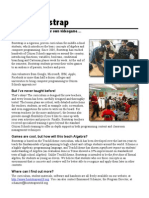Performing Raw SQL Queries - Django Documentation - Django
Uploaded by
Christian Valdez ChávezPerforming Raw SQL Queries - Django Documentation - Django
Uploaded by
Christian Valdez Chávez26/08/13
Performing raw SQL queries | Django documentation | Django
PerformingrawSQLqueries
WhenthemodelqueryAPIsdontgofarenough,youcanfallbacktowritingrawSQL.Djangogivesyoutwo waysofperformingrawSQLqueries:youcanuseM a n a g e r . r a w ( ) toperformrawqueriesandreturn modelinstances,oryoucanavoidthemodellayerentirelyandexecutecustomSQLdirectly.
Performingrawqueries
Ther a w ( ) managermethodcanbeusedtoperformrawSQLqueriesthatreturnmodelinstances:
M a n a g e r . r a w (raw_query,params=None,translations=None)
ThismethodmethodtakesarawSQLquery,executesit,andreturnsa d j a n g o . d b . m o d e l s . q u e r y . R a w Q u e r y S e t instance.ThisR a w Q u e r y S e t instancecanbeiteratedover justlikeannormalQuerySettoprovideobjectinstances. Thisisbestillustratedwithanexample.Supposeyouvegotthefollowingmodel:
c l a s sP e r s o n ( m o d e l s . M o d e l ) : f i r s t _ n a m e=m o d e l s . C h a r F i e l d ( . . . ) l a s t _ n a m e=m o d e l s . C h a r F i e l d ( . . . ) b i r t h _ d a t e=m o d e l s . D a t e F i e l d ( . . . )
YoucouldthenexecutecustomSQLlikeso: > > >f o rpi nP e r s o n . o b j e c t s . r a w ( ' S E L E C T*F R O Mm y a p p _ p e r s o n ' ) : . . . p r i n t ( p ) J o h nS m i t h J a n eJ o n e s Ofcourse,thisexampleisntveryexcitingitsexactlythesameasrunningP e r s o n . o b j e c t s . a l l ( ) . However,r a w ( ) hasabunchofotheroptionsthatmakeitverypowerful. Modeltablenames WheredthenameoftheP e r s o n tablecomefrominthatexample? Bydefault,Djangofiguresoutadatabasetablenamebyjoiningthemodelsapplabelthe nameyouusedinm a n a g e . p ys t a r t a p p tothemodelsclassname,withanunderscore betweenthem.IntheexampleweveassumedthattheP e r s o n modellivesinanappnamed m y a p p ,soitstablewouldbem y a p p _ p e r s o n . Formoredetailscheckoutthedocumentationforthed b _ t a b l e option,whichalsoletsyou manuallysetthedatabasetablename.
Warning NocheckingisdoneontheSQLstatementthatispassedinto. r a w ( ) .Djangoexpectsthat thestatementwillreturnasetofrowsfromthedatabase,butdoesnothingtoenforcethat.If thequerydoesnotreturnrows,a(possiblycryptic)errorwillresult.
Mappingqueryfieldstomodelfields
r a w ( ) automaticallymapsfieldsinthequerytofieldsonthemodel. Theorderoffieldsinyourquerydoesntmatter.Inotherwords,bothofthefollowingqueriesworkidentically: > > >P e r s o n . o b j e c t s . r a w ( ' S E L E C Ti d ,f i r s t _ n a m e ,l a s t _ n a m e ,b i r t h _ d a t eF R O Mm y a p p _ p e r s o n ' )
https://docs.djangoproject.com/en/dev/topics/db/sql/
1/5
26/08/13
Performing raw SQL queries | Django documentation | Django
. . . > > >P e r s o n . o b j e c t s . r a w ( ' S E L E C Tl a s t _ n a m e ,b i r t h _ d a t e ,f i r s t _ n a m e ,i dF R O Mm y a p p _ p e r s o n ' ) . . .
Matchingisdonebyname.ThismeansthatyoucanuseSQLsA S clausestomapfieldsinthequeryto modelfields.SoifyouhadsomeothertablethathadP e r s o n datainit,youcouldeasilymapitinto P e r s o n instances: > > >P e r s o n . o b j e c t s . r a w ( ' ' ' S E L E C Tf i r s tA Sf i r s t _ n a m e , . . . l a s tA Sl a s t _ n a m e , . . . b dA Sb i r t h _ d a t e , . . . p ka si d , . . . F R O Ms o m e _ o t h e r _ t a b l e ' ' ' ) Aslongasthenamesmatch,themodelinstanceswillbecreatedcorrectly. Alternatively,youcanmapfieldsinthequerytomodelfieldsusingthet r a n s l a t i o n s argumenttor a w ( ) . Thisisadictionarymappingnamesoffieldsinthequerytonamesoffieldsonthemodel.Forexample,the abovequerycouldalsobewritten: > > >n a m e _ m a p={ ' f i r s t ' :' f i r s t _ n a m e ' ,' l a s t ' :' l a s t _ n a m e ' ,' b d ' :' b i r t h _ d a t e ' ,' p k ' :' i d ' > > >P e r s o n . o b j e c t s . r a w ( ' S E L E C T*F R O Ms o m e _ o t h e r _ t a b l e ' ,t r a n s l a t i o n s = n a m e _ m a p )
Indexlookups
r a w ( ) supportsindexing,soifyouneedonlythefirstresultyoucanwrite: > > >f i r s t _ p e r s o n=P e r s o n . o b j e c t s . r a w ( ' S E L E C T*f r o mm y a p p _ p e r s o n ' ) [ 0 ] However,theindexingandslicingarenotperformedatthedatabaselevel.Ifyouhaveabigamountof P e r s o n objectsinyourdatabase,itismoreefficienttolimitthequeryattheSQLlevel: > > >f i r s t _ p e r s o n=P e r s o n . o b j e c t s . r a w ( ' S E L E C T*f r o mm y a p p _ p e r s o nL I M I T1 ' ) [ 0 ]
Deferringmodelfields
Fieldsmayalsobeleftout: > > >p e o p l e=P e r s o n . o b j e c t s . r a w ( ' S E L E C Ti d ,f i r s t _ n a m eF R O Mm y a p p _ p e r s o n ' ) TheP e r s o n objectsreturnedbythisquerywillbedeferredmodelinstances(seed e f e r ( ) ).Thismeans thatthefieldsthatareomittedfromthequerywillbeloadedondemand.Forexample: > > >f o rpi nP e r s o n . o b j e c t s . r a w ( ' S E L E C Ti d ,f i r s t _ n a m eF R O Mm y a p p _ p e r s o n ' ) : . . . p r i n t ( p . f i r s t _ n a m e ,#T h i sw i l lb er e t r i e v e db yt h eo r i g i n a lq u e r y . . . p . l a s t _ n a m e )#T h i sw i l lb er e t r i e v e do nd e m a n d . . . J o h nS m i t h J a n eJ o n e s Fromoutwardappearances,thislookslikethequeryhasretrievedboththefirstnameandlastname. However,thisexampleactuallyissued3queries.Onlythefirstnameswereretrievedbytheraw()query thelastnameswerebothretrievedondemandwhentheywereprinted.
ThisdocumentisforDjango'sdevelopmentversion,whichcanbesignificantly differentfrompreviousreleases.Forolderreleases,usetheversionselectorfloating Thereisonlyonefieldthatyoucantleaveouttheprimarykeyfield.Djangousestheprimarykeyto inthebottomrightcornerofthispage. identifymodelinstances,soitmustalwaysbeincludedinarawquery.AnI n v a l i d Q u e r y exceptionwill
beraisedifyouforgettoincludetheprimarykey.
https://docs.djangoproject.com/en/dev/topics/db/sql/
2/5
26/08/13
Performing raw SQL queries | Django documentation | Django
Addingannotations
Youcanalsoexecutequeriescontainingfieldsthatarentdefinedonthemodel.Forexample,wecoulduse PostgreSQLsage()functiontogetalistofpeoplewiththeiragescalculatedbythedatabase: > > >p e o p l e=P e r s o n . o b j e c t s . r a w ( ' S E L E C T* ,a g e ( b i r t h _ d a t e )A Sa g eF R O Mm y a p p _ p e r s o n ' ) > > >f o rpi np e o p l e : . . . p r i n t ( " % si s% s . "%( p . f i r s t _ n a m e ,p . a g e ) ) J o h ni s3 7 . J a n ei s4 2 . . . .
Passingparametersintor a w ( )
Ifyouneedtoperformparameterizedqueries,youcanusethep a r a m s argumenttor a w ( ) : > > >l n a m e=' D o e ' > > >P e r s o n . o b j e c t s . r a w ( ' S E L E C T*F R O Mm y a p p _ p e r s o nW H E R El a s t _ n a m e=% s ' ,[ l n a m e ] )
p a r a m s isalistordictionaryofparameters.Youlluse% s placeholdersinthequerystringforalist,or % ( k e y ) s placeholdersforadictionary(wherek e y isreplacedbyadictionarykey,ofcourse),regardlessof yourdatabaseengine.Suchplaceholderswillbereplacedwithparametersfromthep a r a m s argument. Note DictionaryparamsnotsupportedwithSQLite DictionaryparamsarenotsupportedwiththeSQLitebackendwiththisbackend,youmust passparametersasalist.
Warning Donotusestringformattingonrawqueries! Itstemptingtowritetheabovequeryas: > > >q u e r y=' S E L E C T*F R O Mm y a p p _ p e r s o nW H E R El a s t _ n a m e=% s '%l n a m e > > >P e r s o n . o b j e c t s . r a w ( q u e r y )
Dont. Usingthep a r a m s argumentcompletelyprotectsyoufromSQLinjectionattacks,acommon exploitwhereattackersinjectarbitrarySQLintoyourdatabase.Ifyouusestringinterpolation, soonerorlateryoullfallvictimtoSQLinjection.Aslongasyouremembertoalwaysusethe p a r a m s argumentyoullbeprotected.
ChangedinDjango1.6: InDjango1.5andearlier,youcouldpassparametersasdictionarieswhenusingPostgreSQLorMySQL,although thiswasntdocumented.NowyoucanalsodothiswhemusingOracle,anditisofficiallysupported.
ExecutingcustomSQLdirectly
SometimesevenM a n a g e r . r a w ( ) isntquiteenough:youmightneedtoperformqueriesthatdontmap cleanlytomodels,ordirectlyexecuteU P D A T E ,I N S E R T ,orD E L E T E queries. Inthesecases,youcanalwaysaccessthedatabasedirectly,routingaroundthemodellayerentirely.
https://docs.djangoproject.com/en/dev/topics/db/sql/
3/5
26/08/13
Performing raw SQL queries | Django documentation | Django
Theobjectd j a n g o . d b . c o n n e c t i o n representsthedefaultdatabaseconnection.Tousethedatabase connection,callc o n n e c t i o n . c u r s o r ( ) togetacursorobject.Then,call c u r s o r . e x e c u t e ( s q l ,[ p a r a m s ] ) toexecutetheSQLandc u r s o r . f e t c h o n e ( ) or c u r s o r . f e t c h a l l ( ) toreturntheresultingrows. Forexample: f r o md j a n g o . d bi m p o r tc o n n e c t i o n
d e fm y _ c u s t o m _ s q l ( s e l f ) : c u r s o r=c o n n e c t i o n . c u r s o r ( )
c u r s o r . e x e c u t e ( " U P D A T Eb a rS E Tf o o=1W H E R Eb a z=% s " ,[ s e l f . b a z ] ) c u r s o r . e x e c u t e ( " S E L E C Tf o oF R O Mb a rW H E R Eb a z=% s " ,[ s e l f . b a z ] ) r o w=c u r s o r . f e t c h o n e ( )
r e t u r nr o w
ChangedinDjango1.6: InDjango1.5andearlier,afterperformingadatachangingoperation,youhadtocall t r a n s a c t i o n . c o m m i t _ u n l e s s _ m a n a g e d ( ) toensureyourchangeswerecommittedtothedatabase.Since Djangonowdefaultstodatabaselevelautocommit,thisisntnecessaryanylonger.
Notethatifyouwanttoincludeliteralpercentsignsinthequery,youhavetodoubletheminthecaseyou arepassingparameters: c u r s o r . e x e c u t e ( " S E L E C Tf o oF R O Mb a rW H E R Eb a z=' 3 0 % ' " ) c u r s o r . e x e c u t e ( " S E L E C Tf o oF R O Mb a rW H E R Eb a z=' 3 0 % % 'a n di d=% s " ,[ s e l f . i d ] )
Ifyouareusingmorethanonedatabase,youcanused j a n g o . d b . c o n n e c t i o n s toobtaintheconnection (andcursor)foraspecificdatabase.d j a n g o . d b . c o n n e c t i o n s isadictionarylikeobjectthatallowsyou toretrieveaspecificconnectionusingitsalias: f r o md j a n g o . d bi m p o r tc o n n e c t i o n s c u r s o r=c o n n e c t i o n s [ ' m y _ d b _ a l i a s ' ] . c u r s o r ( ) #Y o u rc o d eh e r e . . . Bydefault,thePythonDBAPIwillreturnresultswithouttheirfieldnames,whichmeansyouendupwitha l i s t ofvalues,ratherthanad i c t .Atasmallperformancecost,youcanreturnresultsasad i c t byusing somethinglikethis:
d e fd i c t f e t c h a l l ( c u r s o r ) : " R e t u r n sa l lr o w sf r o mac u r s o ra sad i c t " d e s c=c u r s o r . d e s c r i p t i o n r e t u r n[ d i c t ( z i p ( [ c o l [ 0 ]f o rc o li nd e s c ] ,r o w ) ) f o rr o wi nc u r s o r . f e t c h a l l ( ) ]
Hereisanexampleofthedifferencebetweenthetwo: > > >c u r s o r . e x e c u t e ( " S E L E C Ti d ,p a r e n t _ i df r o mt e s tL I M I T2 " ) ; > > >c u r s o r . f e t c h a l l ( ) ( ( 5 4 3 6 0 9 8 2 L ,N o n e ) ,( 5 4 3 6 0 8 8 0 L ,N o n e ) ) > > >c u r s o r . e x e c u t e ( " S E L E C Ti d ,p a r e n t _ i df r o mt e s tL I M I T2 " ) ; > > >d i c t f e t c h a l l ( c u r s o r ) [ { ' p a r e n t _ i d ' :N o n e ,' i d ' :5 4 3 6 0 9 8 2 L } ,{ ' p a r e n t _ i d ' :N o n e ,' i d ' :5 4 3 6 0 8 8 0 L } ]
https://docs.djangoproject.com/en/dev/topics/db/sql/
4/5
26/08/13
Performing raw SQL queries | Django documentation | Django
Connectionsandcursors
c o n n e c t i o n andc u r s o r mostlyimplementthestandardPythonDBAPIdescribedinPEP249except whenitcomestotransactionhandling. IfyourenotfamiliarwiththePythonDBAPI,notethattheSQLstatementinc u r s o r . e x e c u t e ( ) uses placeholders," % s " ,ratherthanaddingparametersdirectlywithintheSQL.Ifyouusethistechnique,the underlyingdatabaselibrarywillautomaticallyescapeyourparametersasnecessary. AlsonotethatDjangoexpectsthe" % s " placeholder,notthe" ? " placeholder,whichisusedbytheSQLite Pythonbindings.Thisisforthesakeofconsistencyandsanity.
Managers
Databasetransactions
20052013DjangoSoftwareFoundationunlessotherwisenoted.DjangoisaregisteredtrademarkoftheDjangoSoftware Foundation.LinuxWebhostinggraciouslyprovidedbyMediaTemple.
https://docs.djangoproject.com/en/dev/topics/db/sql/
5/5
You might also like
- Hourglass Workout Program by Luisagiuliet 276% (21)Hourglass Workout Program by Luisagiuliet 251 pages
- The Hold Me Tight Workbook - Dr. Sue Johnson100% (16)The Hold Me Tight Workbook - Dr. Sue Johnson187 pages
- Read People Like A Book by Patrick King-Edited62% (66)Read People Like A Book by Patrick King-Edited12 pages
- Livingood, Blake - Livingood Daily Your 21-Day Guide To Experience Real Health77% (13)Livingood, Blake - Livingood Daily Your 21-Day Guide To Experience Real Health260 pages
- COSMIC CONSCIOUSNESS OF HUMANITY - PROBLEMS OF NEW COSMOGONY (V.P.Kaznacheev,. Л. V. Trofimov.)94% (212)COSMIC CONSCIOUSNESS OF HUMANITY - PROBLEMS OF NEW COSMOGONY (V.P.Kaznacheev,. Л. V. Trofimov.)212 pages
- Donald Trump & Jeffrey Epstein Rape Lawsuit and Affidavits83% (1016)Donald Trump & Jeffrey Epstein Rape Lawsuit and Affidavits13 pages
- The 36 Questions That Lead To Love - The New York Times94% (34)The 36 Questions That Lead To Love - The New York Times3 pages
- The 36 Questions That Lead To Love - The New York Times95% (21)The 36 Questions That Lead To Love - The New York Times3 pages
- Jeffrey Epstein39s Little Black Book Unredacted PDF75% (12)Jeffrey Epstein39s Little Black Book Unredacted PDF95 pages
- The 4 Hour Workweek, Expanded and Updated by Timothy Ferriss - Excerpt23% (954)The 4 Hour Workweek, Expanded and Updated by Timothy Ferriss - Excerpt38 pages
- Electronic Devices and Circuit Theory 11th Ed., Robert L. Boylestad - Free Download, Borrow, and Streaming - Internet ArchiveNo ratings yetElectronic Devices and Circuit Theory 11th Ed., Robert L. Boylestad - Free Download, Borrow, and Streaming - Internet Archive1 page
- Design and Implementation of A Web Based Electronic Court Case Management System5g5r41aze7No ratings yetDesign and Implementation of A Web Based Electronic Court Case Management System5g5r41aze716 pages
- Django Graphos Documentation: Release 0.0.2a0No ratings yetDjango Graphos Documentation: Release 0.0.2a019 pages
- Pentru Instalare Bootstrap: Tutorial Bootstrap - Ce Este Si Cum Il FolosimNo ratings yetPentru Instalare Bootstrap: Tutorial Bootstrap - Ce Este Si Cum Il Folosim2 pages
- Model Field Reference Django Documentation DjangoNo ratings yetModel Field Reference Django Documentation Django20 pages
- Bitnami Djangostack 1.3.1-3 Quick Start GuideNo ratings yetBitnami Djangostack 1.3.1-3 Quick Start Guide14 pages
- Introduction To Django 1221867881702938 8No ratings yetIntroduction To Django 1221867881702938 817 pages
- Django-Fcm Documentation: Release 0.0.2No ratings yetDjango-Fcm Documentation: Release 0.0.221 pages
- Pythondjango - Onlinetraining - Vlrtraining PDFNo ratings yetPythondjango - Onlinetraining - Vlrtraining PDF4 pages
- RUMBLE-2018 Django Workshop: Microsoft Student Chapter, TIETNo ratings yetRUMBLE-2018 Django Workshop: Microsoft Student Chapter, TIET4 pages
- Advance: Django: Python Web Framework (Part-2)No ratings yetAdvance: Django: Python Web Framework (Part-2)20 pages
- Django-Marcador Tutorial - Bookmark Application-V2No ratings yetDjango-Marcador Tutorial - Bookmark Application-V266 pages
- Getting Started With Django On Heroku - Heroku Dev CenterNo ratings yetGetting Started With Django On Heroku - Heroku Dev Center6 pages
- Chapter-9 Creating A Django Based Basic Web ApplicationNo ratings yetChapter-9 Creating A Django Based Basic Web Application10 pages
- Chapter 15 Django Based Web Application Part INo ratings yetChapter 15 Django Based Web Application Part I24 pages
- Django Part-1: Creating The Basic Web App Using Django Web FrameworkNo ratings yetDjango Part-1: Creating The Basic Web App Using Django Web Framework19 pages
- The Django Framework MSCOSCONF2009 #MOSC2010No ratings yetThe Django Framework MSCOSCONF2009 #MOSC201019 pages
- Tutorial: Creating Struts Application in EclipseNo ratings yetTutorial: Creating Struts Application in Eclipse57 pages
- Python - Filtering in Many To Many Relationship in Django - Stack OverflowNo ratings yetPython - Filtering in Many To Many Relationship in Django - Stack Overflow2 pages
- SRS - Assign-1 (A, F171BCSE050, Syed Shahabal Shah)No ratings yetSRS - Assign-1 (A, F171BCSE050, Syed Shahabal Shah)2 pages
- HP ALU T2 6.7 NG WAN - TIMOS Upgrade Procedure v1.0No ratings yetHP ALU T2 6.7 NG WAN - TIMOS Upgrade Procedure v1.010 pages
- The Role of Management Information System in Organizational Decision Making (A Case Study at Ethio-Telecom, Jimma Branch)100% (4)The Role of Management Information System in Organizational Decision Making (A Case Study at Ethio-Telecom, Jimma Branch)45 pages
- Computer - Introduction To Adobe PhotoshopNo ratings yetComputer - Introduction To Adobe Photoshop27 pages
- Cobol (Common Business Oriented Language)No ratings yetCobol (Common Business Oriented Language)38 pages
- Creation of Query Report With Additional Calculated FieldNo ratings yetCreation of Query Report With Additional Calculated Field11 pages
- Scilab Image and Video Processing Toolbox Sivp-doc-2006.EnNo ratings yetScilab Image and Video Processing Toolbox Sivp-doc-2006.En18 pages
- Problems and Solutions in Software MaintenanceNo ratings yetProblems and Solutions in Software Maintenance3 pages
- Thomas (Tom) Pall: Senior Oracle DBA/Oracle ArchitectNo ratings yetThomas (Tom) Pall: Senior Oracle DBA/Oracle Architect6 pages
- Livingood, Blake - Livingood Daily Your 21-Day Guide To Experience Real HealthLivingood, Blake - Livingood Daily Your 21-Day Guide To Experience Real Health
- COSMIC CONSCIOUSNESS OF HUMANITY - PROBLEMS OF NEW COSMOGONY (V.P.Kaznacheev,. Л. V. Trofimov.)COSMIC CONSCIOUSNESS OF HUMANITY - PROBLEMS OF NEW COSMOGONY (V.P.Kaznacheev,. Л. V. Trofimov.)
- Donald Trump & Jeffrey Epstein Rape Lawsuit and AffidavitsDonald Trump & Jeffrey Epstein Rape Lawsuit and Affidavits
- The 36 Questions That Lead To Love - The New York TimesThe 36 Questions That Lead To Love - The New York Times
- The 36 Questions That Lead To Love - The New York TimesThe 36 Questions That Lead To Love - The New York Times
- Jeffrey Epstein39s Little Black Book Unredacted PDFJeffrey Epstein39s Little Black Book Unredacted PDF
- The 4 Hour Workweek, Expanded and Updated by Timothy Ferriss - ExcerptThe 4 Hour Workweek, Expanded and Updated by Timothy Ferriss - Excerpt
- Electronic Devices and Circuit Theory 11th Ed., Robert L. Boylestad - Free Download, Borrow, and Streaming - Internet ArchiveElectronic Devices and Circuit Theory 11th Ed., Robert L. Boylestad - Free Download, Borrow, and Streaming - Internet Archive
- Design and Implementation of A Web Based Electronic Court Case Management System5g5r41aze7Design and Implementation of A Web Based Electronic Court Case Management System5g5r41aze7
- Pentru Instalare Bootstrap: Tutorial Bootstrap - Ce Este Si Cum Il FolosimPentru Instalare Bootstrap: Tutorial Bootstrap - Ce Este Si Cum Il Folosim
- RUMBLE-2018 Django Workshop: Microsoft Student Chapter, TIETRUMBLE-2018 Django Workshop: Microsoft Student Chapter, TIET
- Django-Marcador Tutorial - Bookmark Application-V2Django-Marcador Tutorial - Bookmark Application-V2
- Getting Started With Django On Heroku - Heroku Dev CenterGetting Started With Django On Heroku - Heroku Dev Center
- Chapter-9 Creating A Django Based Basic Web ApplicationChapter-9 Creating A Django Based Basic Web Application
- Django Part-1: Creating The Basic Web App Using Django Web FrameworkDjango Part-1: Creating The Basic Web App Using Django Web Framework
- Python - Filtering in Many To Many Relationship in Django - Stack OverflowPython - Filtering in Many To Many Relationship in Django - Stack Overflow
- SRS - Assign-1 (A, F171BCSE050, Syed Shahabal Shah)SRS - Assign-1 (A, F171BCSE050, Syed Shahabal Shah)
- HP ALU T2 6.7 NG WAN - TIMOS Upgrade Procedure v1.0HP ALU T2 6.7 NG WAN - TIMOS Upgrade Procedure v1.0
- The Role of Management Information System in Organizational Decision Making (A Case Study at Ethio-Telecom, Jimma Branch)The Role of Management Information System in Organizational Decision Making (A Case Study at Ethio-Telecom, Jimma Branch)
- Creation of Query Report With Additional Calculated FieldCreation of Query Report With Additional Calculated Field
- Scilab Image and Video Processing Toolbox Sivp-doc-2006.EnScilab Image and Video Processing Toolbox Sivp-doc-2006.En
- Thomas (Tom) Pall: Senior Oracle DBA/Oracle ArchitectThomas (Tom) Pall: Senior Oracle DBA/Oracle Architect























































































































